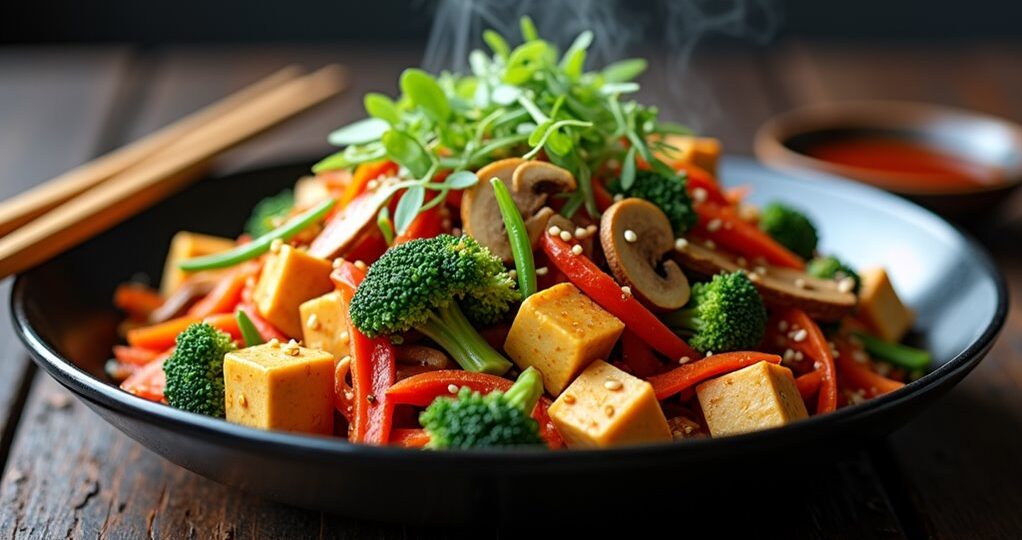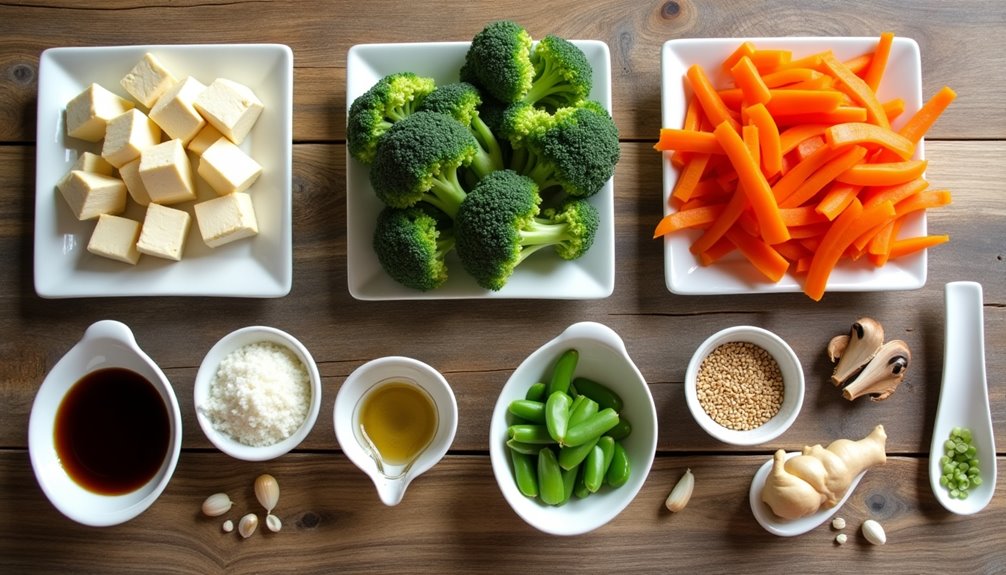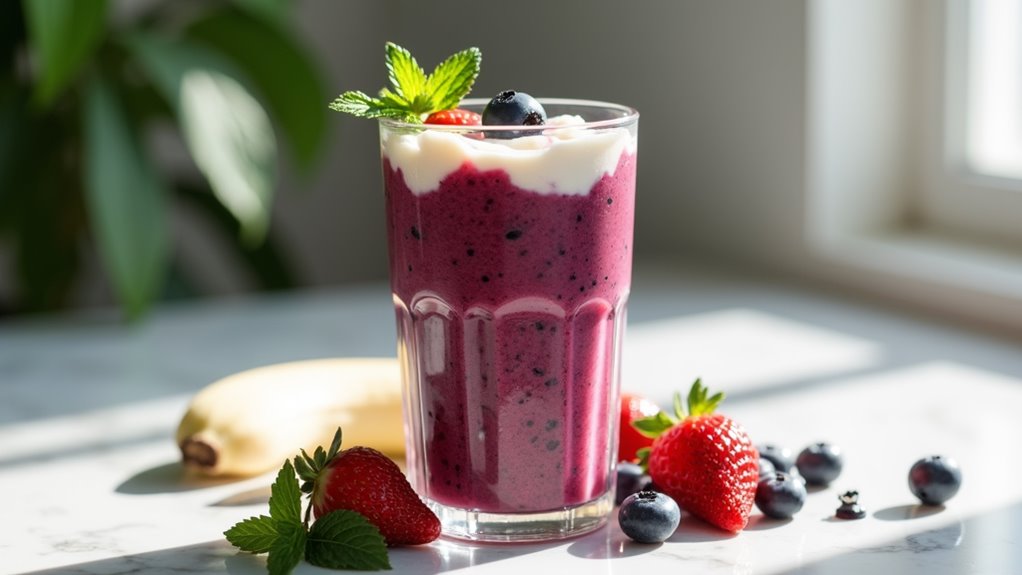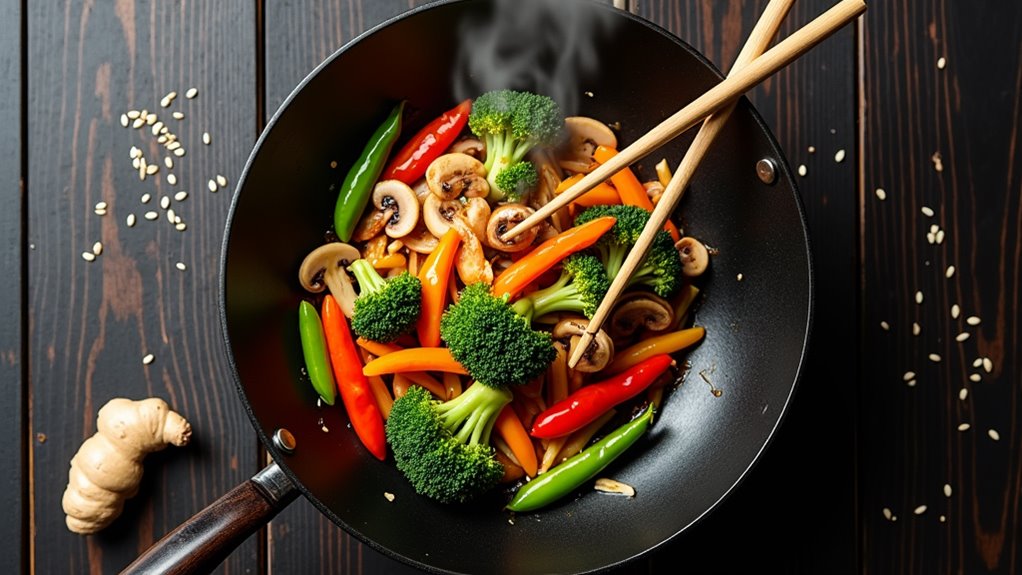5 Best Plant-Based Stir-Fry Recipes For Fasting
January 7, 2025 | by Nutrition Hub 101

When you're fasting, you'll want meals that are both nourishing and satisfying, and plant-based stir-fries fit the bill perfectly. These quick-cooking dishes have evolved from ancient Asian culinary traditions into modern, health-conscious preparations that support various fasting protocols. While the basic concept might seem straightforward, there's an art to creating stir-fries that deliver both ideal nutrition and authentic flavor. From the precise timing of adding ingredients to selecting the right combination of vegetables and proteins, these five time-tested recipes will transform your fasting experience from one of restriction to one of culinary exploration.
History
Many plant-based stir-fry dishes trace their roots back to ancient Chinese Buddhist cuisine, where vegetarian cooking emerged as a significant dietary practice over 2,000 years ago.
As Buddhism spread across Asia, monks developed innovative ways to create satisfying meals without meat, leading to the evolution of plant-based stir-frying techniques.
You'll find that stir-frying vegetables became popular during the Han Dynasty (206 BCE – 220 CE), when wok cooking gained prominence.
The quick cooking method helped preserve the nutrients and flavors of vegetables while using minimal oil.
During times of fasting, Buddhist practitioners relied on these techniques to create filling meals using tofu, mushrooms, and seasonal vegetables.
In the modern era, you've likely noticed plant-based stir-fries gaining popularity worldwide, especially during fasting periods in various cultures.
The technique has adapted to incorporate global ingredients while maintaining its core principles of quick cooking and minimal processing.
Today's plant-based stir-fries blend traditional Buddhist vegetarian cooking methods with contemporary ingredients like tempeh, seitan, and quinoa, offering you versatile options for fasting days while honoring the ancient roots of this cooking style.
Recipe

Plant-Based Stir-Fry with Asian-Inspired Sauce
This vibrant plant-based stir-fry combines colorful vegetables and protein-rich tofu in a savory Asian-inspired sauce. The dish offers a perfect balance of textures and flavors, from crisp-tender vegetables to chewy tofu cubes, all enveloped in a rich umami sauce that clings perfectly to each component.
The key to this recipe's success lies in the preparation and timing. By cutting all vegetables uniformly and cooking them in a specific order based on their density, each ingredient maintains its ideal texture while contributing to the overall harmony of the dish.
Ingredients:
- 14 oz extra-firm tofu, pressed and cubed
- 2 carrots, julienned
- 2 cups broccoli florets
- 1 red bell pepper, sliced
- 1 cup snap peas
- 2 cups mushrooms, sliced
- 3 cloves garlic, minced
- 1 inch ginger, grated
- 4 tablespoons soy sauce
- 2 tablespoons rice vinegar
- 1 tablespoon cornstarch
- 1 tablespoon sesame oil
- 2 tablespoons vegetable oil
- 2 green onions, sliced
- 1 tablespoon sesame seeds
Press tofu for 30 minutes, then cube and pan-fry in vegetable oil until golden. Remove and set aside.
Heat remaining oil in a wok over high heat, add garlic and ginger until fragrant. Add carrots and broccoli, stir-fry for 2 minutes. Add bell pepper and mushrooms, cook for 2 minutes.
Add snap peas and return tofu to wok. Mix cornstarch with soy sauce and rice vinegar, pour into wok. Stir until sauce thickens, add sesame oil, and garnish with green onions and sesame seeds.
For best results, make certain your wok or pan is thoroughly heated before beginning, and don't overcrowd the pan as this will steam rather than stir-fry the vegetables.
Cut all vegetables to similar sizes for even cooking, and have all ingredients prepped and ready before starting, as stir-frying moves quickly.
The tofu can be pressed and marinated overnight for extra flavor, and the sauce ingredients can be mixed ahead of time.
Final Thoughts
While mastering stir-fry techniques takes practice, you'll find this recipe offers endless opportunities for customization and creativity. You can swap vegetables based on seasonal availability or personal preference, adjust the sauce ingredients to match your taste, and experiment with different plant-based proteins like tofu, tempeh, or seitan.
Remember to prep all ingredients before heating your wok or pan, as stir-frying moves quickly once you start. Don't overcrowd your pan – cooking in batches guarantees each ingredient maintains its texture and caramelizes properly. Keep your heat high and your vegetables moving to achieve that perfect balance of crisp-tender texture.
If you're new to plant-based cooking, this stir-fry recipe serves as an excellent foundation for building your culinary skills. You'll learn valuable techniques like proper knife work, timing, and heat management.
As you become more confident, try incorporating different Asian-inspired sauces, spices, and aromatics to create your signature dishes. Whether you're fasting, shifting to a plant-based diet, or simply enjoying more meatless meals, this versatile cooking method will become a staple in your kitchen repertoire.
RELATED POSTS
View all

